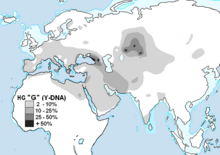| Haplogroup G | |
|---|---|
 | |
| Possible time of origin | 48,500 years before present[1] |
| Coalescence age | 25,200 years before present[1] |
| Possible place of origin | West Asia |
| Ancestor | Haplogroup GHIJK |
| Descendants | primary: G1, G2 |
| Defining mutations | M201, PF2957, L116, L154, L204, L240, L269, L402, L520, L521, L522, L523, L605, L769, L770, L836, L837, M201, P257/U6, Page94/U17, U2, U3, U7, U12, U20, U21, U23, U33 |
Haplogroup G (M201) is a human Y-chromosome haplogroup. It is one of two branches of the parent haplogroup GHIJK, the other being HIJK.
G-M201 is most commonly found among various ethnic groups of the Caucasus, but is also widely distributed at low frequencies among ethnic groups throughout Europe, West Asia, South Asia, Central Asia, and North Africa.
The most commonly occurring subclades are G1* (M285) and many subclades of G2 (G-P287), especially: G2a (P15), G2a1 (G-FGC7535, formerly G-L293), G2a2b2a (G-P303) formerly G2a3b1); G2a2b1 (G-M406) formerly G2a3a; G2a2b2a1 (G-L140) formerly G2a3b1a; G2a2b2a1a1b (G-L497) formerly G2a3b1a2; G2a2b2a1a1a1 (G-L13) formerly G2a3b1a1a; G2a2b2a1a1c1a (G-CTS5990 or G-Z1903) formerly G2a3b1a3; G2b (G-M3115) and; G2b1 (G-M377), formerly G2b.